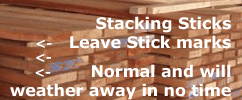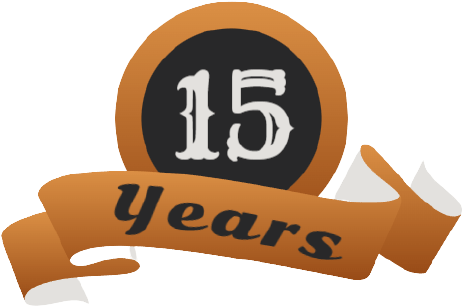FAQ IPE DECKING ARRIVAL
What should I expect when I receive my decking? We strive to insure that your decking arrives in pristine condition. Your decking order could easily weigh over a ton and we assume the average homeowner will not have the forklift needed to remove it from the truck. Instead, you will need a way to cut the straps to open the package. Once opened you can then just hand off the decking to someone on the ground. The warehouse men have offloaded and stacked with an assistant 1500 linear feet of decking this way in approximately 20 minutes. This means you (or your contractor) will need at least two people to unload the truck. If you need more information please review ourShipping FAQ
What is my decking arrives via a Flatbed Trailer? The major difference is their is probably no crating. You will still need at least two people to unload the truck. One person will be on the trailer to hand boards down to the second person.
 Will the delivery person unload my shipment for me? No! The delivery driver will not assist you in unloading your shipment. All residential deliveries are curbside. You must have at least two people at the delivery location to unload your shipment.
Will the delivery person unload my shipment for me? No! The delivery driver will not assist you in unloading your shipment. All residential deliveries are curbside. You must have at least two people at the delivery location to unload your shipment.
 How do I store the decking until I can install it? Always stack your decking flat. You do this one on top of the other preferably off the ground (using a few scrap 2x4s every 3-4 feet). You should also provide air between the stacks (1/4″to 1/2″) for acclimation. If you have a lot of decking, it is a good idea to place spacers (2×4 scrap) about every 6 or 8 rows of deck boards. This will keep your stack stabilized and reduce its tendency to topple. Decking should be kept out of direct sunlight until ready to be installed. Cover your stack of decking if you are leaving it outside beyond a few days or if rain is in the forecast. A tarp will suffice to cover your decking allowing air to circulate through the wood.
How do I store the decking until I can install it? Always stack your decking flat. You do this one on top of the other preferably off the ground (using a few scrap 2x4s every 3-4 feet). You should also provide air between the stacks (1/4″to 1/2″) for acclimation. If you have a lot of decking, it is a good idea to place spacers (2×4 scrap) about every 6 or 8 rows of deck boards. This will keep your stack stabilized and reduce its tendency to topple. Decking should be kept out of direct sunlight until ready to be installed. Cover your stack of decking if you are leaving it outside beyond a few days or if rain is in the forecast. A tarp will suffice to cover your decking allowing air to circulate through the wood.
Acclimation: Our decking is stocked in various warehouses and we ship usually from the closest warehouse. If you are local to this, or have similar humidity, no acclimation is necessary. Because Ipe is supplied as air dried it is necessary to allow the decking to acclimate and stabilize itself to the local temperature and humidity environment prior to installation. Air drying is an acceptable method to do this.
 How long are my deck boards? All our decking is 1-2″ longer than their specified lengths. For example; a 10′ 1×6 could actually be 10′ 2″ long. This is so that you can easily do final trim cuts once your decking is installed. Again, cover your stack of decking if you are leaving it outside beyond a few days or if rain is in the forecast. A tarp will suffice to cover your decking allowing air to circulate through the wood.
How long are my deck boards? All our decking is 1-2″ longer than their specified lengths. For example; a 10′ 1×6 could actually be 10′ 2″ long. This is so that you can easily do final trim cuts once your decking is installed. Again, cover your stack of decking if you are leaving it outside beyond a few days or if rain is in the forecast. A tarp will suffice to cover your decking allowing air to circulate through the wood.
 Why are my deck boards dirty with strange “stick” marks? During manufacture, the saw mill will place Stacking Sticks between layers of decking. Moisture and sawdust will collect between the decking due to the spaces the stacking sticks create. All such marks will disappear in a few weeks. It is always a good idea to clean your deck after installation and before you use any deck UV treatment.
Why are my deck boards dirty with strange “stick” marks? During manufacture, the saw mill will place Stacking Sticks between layers of decking. Moisture and sawdust will collect between the decking due to the spaces the stacking sticks create. All such marks will disappear in a few weeks. It is always a good idea to clean your deck after installation and before you use any deck UV treatment.
What is the yellow stuff on the decking? Similar to the dirty boards, when Ipe is milled they will have a layer of fine yellow powder or dust. This is normal with Ipe and you should expect it. The stacking sticks marks may be pronounced. Cleaning or a strong rain will remove this yellow dust. This yellow dust is reputed that it may cause dermatitis in some individuals that have skin sensitivities and/or cause allergic reactions in those who breathe it in.
 Working with Brazilian Hardwoods: It is recommended that carbide tipped saw blades, power tool bits and cutters are used when machining this wood. Never push a tool beyond its capacity and do not allow cutting surfaces to overheat. Slow down, and allow the tool to do the work. Overheating causes dulling of saw blades, bits and cutters.
Working with Brazilian Hardwoods: It is recommended that carbide tipped saw blades, power tool bits and cutters are used when machining this wood. Never push a tool beyond its capacity and do not allow cutting surfaces to overheat. Slow down, and allow the tool to do the work. Overheating causes dulling of saw blades, bits and cutters.
 End Sealing: After cross-cutting, all fresh cross-cut surfaces should be properly end sealed. We recommend (and stock) a water based wax emulsion end sealer. End sealing helps reduce most end checking before it begins. The sooner the cross cuts are sealed after cutting and/or end trimmed, the more effective it will be.
End Sealing: After cross-cutting, all fresh cross-cut surfaces should be properly end sealed. We recommend (and stock) a water based wax emulsion end sealer. End sealing helps reduce most end checking before it begins. The sooner the cross cuts are sealed after cutting and/or end trimmed, the more effective it will be.


